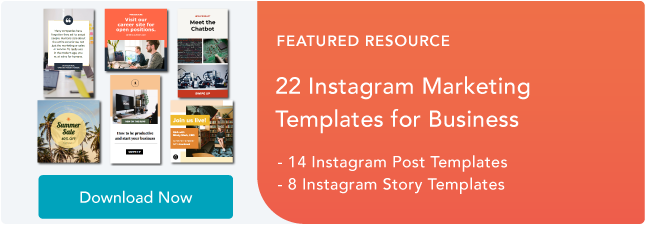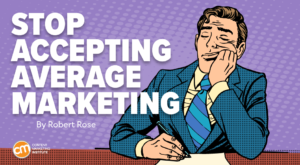![Which Instagram Story Formats Really Engage Viewers [New Research]](https://www.liveseo.com/wp-content/uploads/2022/03/Which-Instagram-Story-Formats-Really-Engage-Viewers-New-Research.jpgkeepProtocol.jpeg)
In 2021, Instagram reported over 500 million users viewed Stories.
Since launching in 2016, the Stories feature alone has made Instagram more popular than other Story and mobile video platform competitors including Snapchat, TikTok, and its owner’s own platform: Facebook Stories.
Even if you’ve already published a handful of branded Stories, you still might want to up your game by making them even more engaging. After all, Stories can provide great benefits related to audience engagement, brand awareness, and even purchase-related conversions.
Despite the growing number of benefits that Instagram Stories offers brands, crafting good content still takes time, energy, and brainstorming. Even when you put your best efforts into creating a Story, you might still find that it falls flat, sees a high drop-off, or shows other signs of low engagement.
As you build your social media content strategy for 2022, you might be asking yourself, “What type of Instagram Story format do people actually engage with?”
In this post, I’ll highlight what consumers said about their favorite Instagram Story formats, the trends marketers are noticing, and show you examples along the way.
Which Formats Marketers Are Leveraging [HubSpot Blog Data]
The HubSpot Blog surveyed over 1,000 marketers to learn more about their marketing strategies in 2022. According to this survey, 78% of marketers leverage Instagram Stories in their roles. Of those who use Instagram Stories, 43% post on behalf of their brand multiple times per week. The marketers in this survey note audience viewership of Instagram Stories declines after four to six Instagram Story pages.
According to the marketers we surveyed, here are the most common Instagram Story types subjects that result in the greatest ROI.
Content That Reflects Brand Values
Per the HubSpot Blog survey, 18% of marketers indicated Instagram Story content that reflected their brand’s values produced the greatest ROI. Considering 71% of consumers want to buy from brands that align with their personal values, this piece of data isn’t surprising.
When companies are upfront about their core values related to topics such as diversity, inclusion, sustainability, and human rights, buyers are able to quickly determine a brand’s stance on a particular topic.
Similarly, it’s important that consumers know why your brand exists, and how you can serve them. Regularly incorporating your company’s mission and vision into your content can also help your audience feel more connected to your brand.
Product-Focused Content
Consumers want to see your product in action! Whether it is through regular demonstrations by your team, user-generated content from other happy customers, or positive reviews, product-related content can deliver positive results. When crafting Instagram Stories, find creative ways to present your products that appeal to your audience.
Interactive Content
On Instagram Stories, interactive frames have a specific call-to-action or way viewers can get involved from within the app. This often includes using Instagram’s Poll or Quiz sticker, inviting users to share a specific piece of content themselves, or a game. Here’s an example from @fentybeauty, who used Instagram’s slide feature to poll their audience.

Trendy Content
Trend-related content entails coverage of a recent cultural moment or news story. This type of content can range from informative (breaking news) to humorous (posting a meme related to a recent event). Trendy content is well-suited for Instagram Stories because of it is best consumed quickly and while relevant. Unlike a feed post that can take days to reach an audience, the 24-hour period an Instagram Story is live can be a great place to share content that is only relevant for a short period of time.
Now that we know what content marketers are prioritizing in Instagram Stories, let’s look at what formats consumers prefer and engage with most often.
Which Format Consumers Are Actually Watching
While some brands and users post Stories focused purely on interactive features, others might post visual storytelling content such as short narratives or longer video stories that feel more like documentaries.
But, which one of the many Instagram Story formats is most intriguing to people? To get to the bottom of which Story style is most engaging, I surveyed 350 people using Lucid software to learn more about their favorite Story formats, sound preferences, and ideal Story length.
I asked consumers, “Which Instagram Story are you most likely to tap all the way through until the end?”
At this point, you may have your own predictions of how people might have voted. While research says that interactive stickers, such as Quizzes, Polls, or Questions are highly engaging, you might also be thinking about the times you’ve tapped through an influencer or brand’s behind-the-scenes videos via their Story. So which, ultimately did people choose?
Stories centered around Quiz or Poll stickers were one of the most popular formats with 15% of the votes. However, 35% of consumers actually prefer short narratives with a mix of photos, text, and videos.
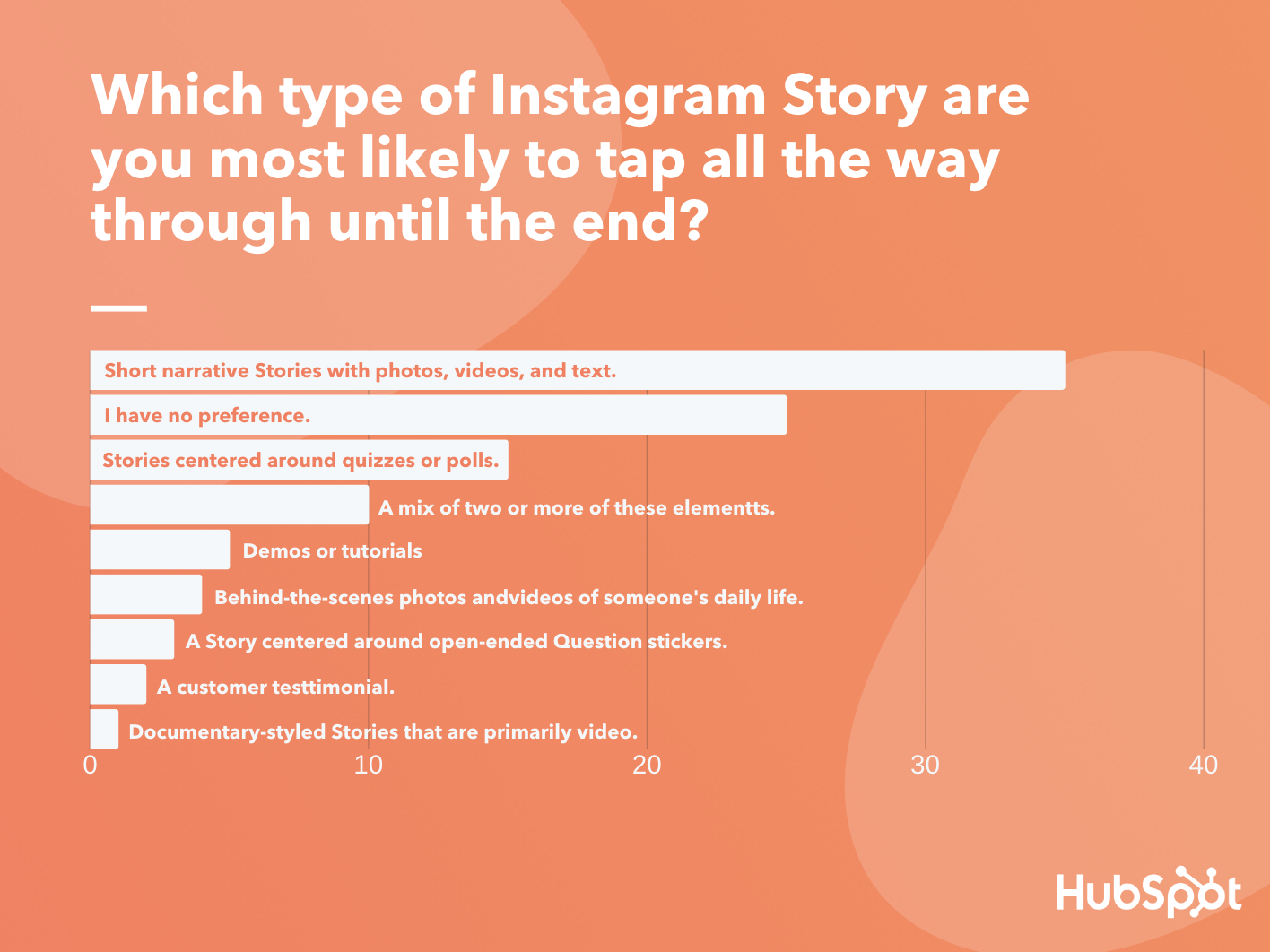
Data Source: Lucid Software
Short Narrative Stories
Short narratives are basically articles translated for a more visual audience. They rely on brief paragraphs and bullet points of text, accompanied by related visuals, to tell a story in a few cohesive short slides. Here’s a great example of a short story that swipes up to a longer piece of web content from Harvard Business Review:
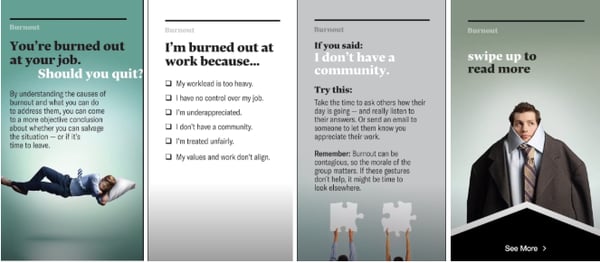
This strategy is a great way to get more eyes on your blog content without asking people to leave the Instagram app.
Aside from informing your audience of a topic related to your industry, you can also take a note from HBR and other publishers by using Stories as a traffic generator. In the example above, HBR — which has a verified account — has adapted a long-form article into a short Story and included the full post at the end as a swipe-up link.
With this tactic, the Instagram Story serves as a teaser as viewers who are very interested in the topic can swipe up to read more about it on HBR.org.
Quiz or Poll-Centered Stories
Another strong Story format uses Quiz or Poll stickers. Essentially, these Stories feel like they are just created to quiz the viewer by including the Quiz sticker on most pages, or brands can leverage Stories with polls primarily on each page to get their audience’s insights on a topic.
These Stories are intriguing and entertaining to viewers because it allows them to test themselves and learn about a new topic interactively, or vote in a poll and see what other audiences think about a certain topic or theme. Here’s an example of an interactive Story from HubSpot which centered around a Poll-styled quiz and revealed the answers at the end.
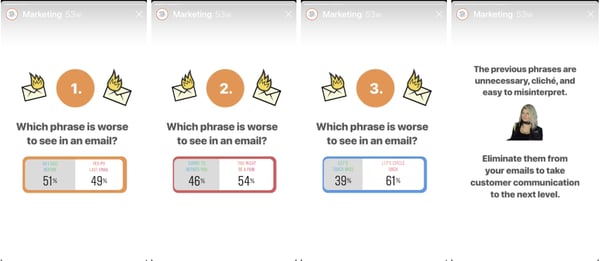
While you can also use an actual Quiz sticker, which will immediately tell viewers quiz questions, HubSpot’s strategy also works as it allows viewers to get a glimpse at what others guessed and see a rundown of the actual answers at the end. This might keep viewers engaged, entertained, and in the Story for longer if they know that there will be a payoff on the last page.
While fewer people voted for Stories centered around Question stickers, this feature could still be a great feature to experiment with as it can help you interact with and learn more about your audience in a more open-ended way that Polls.
Here’s an example of a Question sticker in a HubSpot Story. After this page, the Story went on to share the answers that viewers submitted.
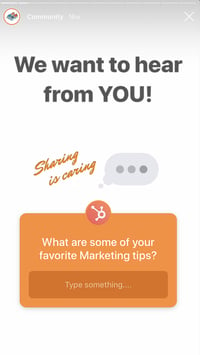
Although open-ended questions seem like a great way to learn about and interact with your audience, keep in mind that viewers will need to take time to fill out answers rather than simply tapping on a Poll or Quiz sticker. This means that if your audience isn’t as interested in the topic or question, you might run into issues getting responses.
If you’d like to learn more about how to use and leverage the Instagram Questions sticker in your Stories, check out this helpful guide which includes examples of brands that used the feature successfully.
Demos and Tutorials
Brands can also leverage tutorials and demos, which was the fifth most popular Story style. This tactic might be especially helpful if you’re interested in ecommerce or purchase-related conversions as a growing number of people prefer to learn more about products via video. Here’s an example of a tutorial from Kylie Cosmetics, where CEO Kylie Jenner puts on a new lip liner from the brand.
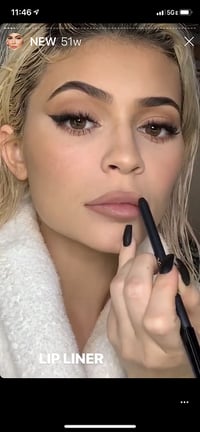
Story formats that include demos or tutorials can be advantageous to brands because it allows them to show off how their products work. Additionally, if you have over 10,000 followers or are a verified user, you can link these Stories to your ecommerce site or a purchasing page for the products shown. This way, if a viewer is impressed by a tutorial or demo, they can simply swipe up to learn more about or purchase the product.
A Mix of Content
Because many people don’t have a preference or prefer a mix of multiple elements in Instagram Stories, be sure to add a bit of variation to your content strategy. For example, brainstorm ways to add interactive features, such as Quiz or Poll stickers to narratives, tutorials, or other types of Story content. This will add an extra layer of engaging content to a Story that might already be interesting to viewers.
Here’s an example of a Story from Starbucks that mixes in storytelling and interactive stickers to announce the return of a popular seasonal beverage:
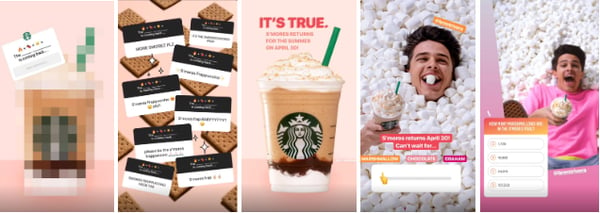
Other Instagram Story Formats
When it came to the Story styles with lower rankings, consumers were actually less interested in behind-the-scenes content, mini-documentaries, and Stories that center around customer testimonials.
This might hint that marketers on these platforms might want to be thinking more creatively when launching content on Instagram Stories. Rather than just focusing on your product or customer testimonials, you might want to test out creating informative short narratives or interactive Stories that relate strongly to your brand. While this will engage Instagram audiences, it might also show off your company’s expertise in its industry.
While this poll deemed a few Story formats less engaging, I still encourage you to mix things up and experiment with some of these styles just in case they work for you. Here are a few to try.
Customer Testimonials
Although customer testimonials aren’t as interesting to consumers, this doesn’t mean that you should scratch them entirely. In fact, they’re still a commonly used tactic in many brands and industries, despite consumer preferences. For example, a number of companies, like Planet Fitness, have built their strategy around testimonials. Here’s an example:
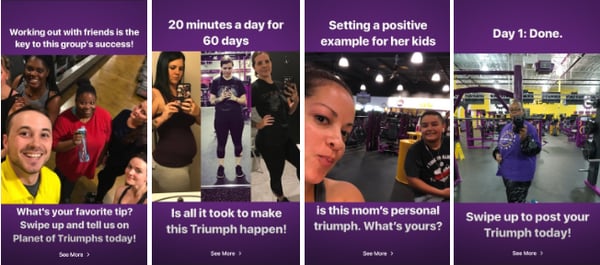
In the above scenario, the customer testimonial strategy works for Planet Fitness because it helps gym prospects feel less intimidated and more motivated to take on physical fitness after seeing a customer’s success story.
Behind-the-Scenes Stories
No, behind-the-scenes Stories don’t necessarily talk about your product front and center, but they can give prospects an idea of what your company is like, the inner workings of your industry, and a look at the staff that customers could work with.
Behind-the-scenes videos allow you to show off how hardworking or relatable your business might be, which might make viewers feel more comfortable working with you.
One example of a brand that uses this technique is the NBA. The basketball league regularly shares videos of professional basketball players behind the scenes at games or celebrations. In the image below, they shared an Instagram Story video of basketball players taking a photo with the rapper Drake:
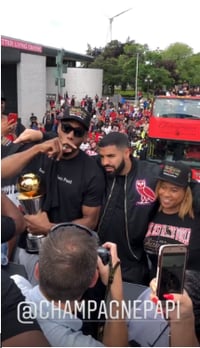
Mini-Documentaries
Like narrative-style Instagram content, mini-documentaries tell journalistic stories that are slightly more complex and primarily centered on video — like a documentary that you tap through.
These are often higher-quality and incredibly informative, so they are more prominently used by publishers such as National Geographic. Here’s just the beginning of a long documentary-styled Story where NatGeo visits NASA’s offices to uncover facts about the first moon landing:
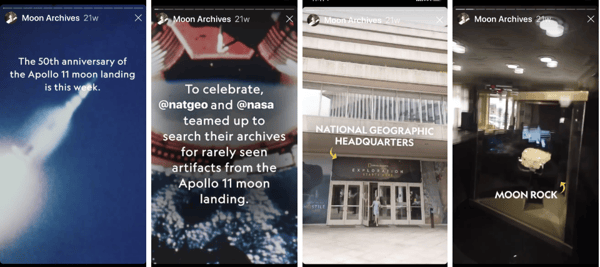
If you’re a small to medium-sized business that’s just ramping up your Instagram strategy, you might want to stick to a short narrative Story, like the ones noted at the beginning of this post. These will allow you to similarly show a combination of videos, photos, and text without as much production time and effort. However, if you’re a content creator or feel like covering an event or newsworthy topic in your industry might boost brand awareness, you might want to experiment with this longer-form, in-depth visual storytelling style.
Ideal Story Length
For years, social media managers have been trying to determine how long the perfect Instagram Story should be. This has been such a major question that marketing blogs and publications have done further research on the matter.
If you’re a small to medium-sized business marketer, Story length is a valid thing to consider, especially if you have low time or resources. While you ideally want to engage people with low dropoff throughout your entire Story, you might not want to spend time making incredibly long pieces of content with multiple pages if you know people in your industry usually only tap through a small number of pages.
So, what exactly is a good Story length? To get some added insight on this, I surveyed the 350 consumers and asked them, “On average, how many pages of an Instagram Story will you tap through before swiping out?”
Before looking at the results, you might think “The ideal Story should be as short as possible,” simply because it’s content on a fast-paced social media platform. But, then, you might also remember that a number of publications, like Harvard Business Publishing and The Washington Post have leveraged Stories as a way to share long-form content.
So, which approach is right and which is wrong?’
It seems that there are solid themes in ideal Story length, however, there still might not be an ideal number of pages in this type of content.
According to the poll, 63% of consumers will tap through six pages or less, with 34% saying they tap through four to six pages on average. This data aligns with the feedback we got from marketers through our HubSpot Blog survey. However, more than one-third of consumers will tap through stories with more than seven pages, with 20% saying they’ll tap through 10 or more.
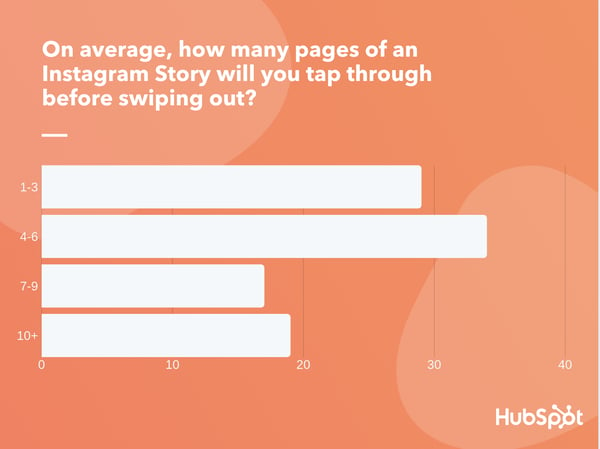
Data Source: Lucid Software
The results above are similar to research published by Buffer which noted that Stories made up of seven or fewer pages are the most engaging. However, the fact that a large chunk of Lucid respondents will watch beyond seven pages hints that you might not need to shrink down your content to ensure that it’s seen.
When determining the best Story length for your audience, we encourage you to consider the age group of your audience, the type of topics they engage with, and how fast-paced their lifestyles might be. If you have an idea for a great topic that your audience will love and is compatible with interactive Story features, you might be able to get away with a longer Story.
If you have a topic that you worry might feel dry or too complex to explain on Stories, you might want to format this as a smaller Story with a sticker linked to longer-form content.
As you start posting regular Instagram Stories, you should also experiment with both long and short Stories. Then, look at the drop-off rate of each Story. If many people seem to drop out of one long story but not another, this might be due to the topic or the writing rather than the length. However, if people regularly drop out of your longer-form Stories around a certain page number, you might want to limit your Story content to that number of pages.
Telling an Engaging Visual Story
Regardless of what topic you’re publishing a Story about, or which format you decide on using, make sure it informs the audience about something they care about, provides entertainment value, and highlights your brand’s credibility in your industry.
If you’re unsure about how you can leverage Instagram Stories to better market your brand, it can be helpful to look at examples from similar companies in your industry.

